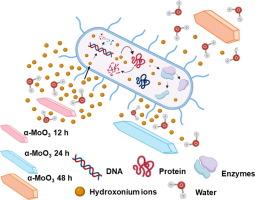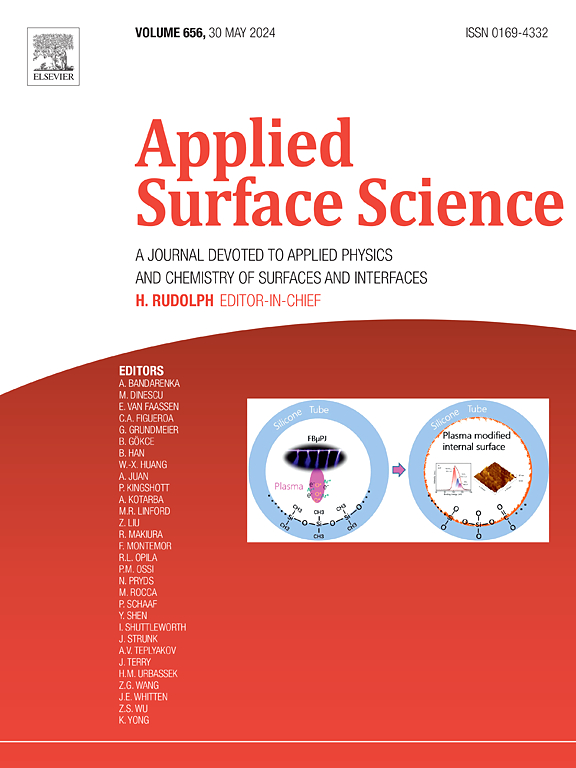The impact of the design of MoO3 nanorods on the bactericidal performance
IF 6.3
2区 材料科学
Q2 CHEMISTRY, PHYSICAL
引用次数: 0
Abstract
Our work evaluates the impact of crystallization rate during the synthesis of α-MoO3 nanorods and their bactericidal performance against Gram (+) S. aureus and Gram (−) E. coli. For this purpose, α-MoO3 nanorods were synthesized by varying the crystallization times to 12, 24, and 48 h. XRD patterns reveal that crystallization time changes crystal size. The growth of α-MoO3 does not show chemical modifications. However, SEM and TEM reveal the characteristic nanorods morphology, where the crystallization times affect the diameter. Crystal growth also changes the atomic percentage of Mo/O, which is determined by XPS. The above was reflected in the antibacterial performance of α-MoO3, evaluated at different nanoparticle concentrations (0.5–4 mg/mL). The α-MoO3 is an efficacious antibacterial for both pathogens by the enhanced crystal size, with higher bactericidal performance against Gram-positive bacteria, indicating that the rod architecture improves their interaction through electrostatic attraction with the peptidoglycan structure of S. aureus bacteria. In addition, electrochemical measurements indicate that the electroactive area of α-MoO3 plays a key role in the nanoparticle/bacteria interaction. As a result, the intrinsic characteristics of α-MoO3 nanorods, including crystal size, morphology, nanorod diameter, oxygen vacancies, and EASA, influence the antibacterial activity, generating materials with potential biomedical applications.

MoO3 纳米棒的设计对杀菌性能的影响
我们的研究评估了α-MoO3 纳米棒合成过程中结晶速率的影响及其对革兰氏(+)金黄色葡萄球菌和革兰氏(-)大肠杆菌的杀菌性能。为此,α-MoO3 纳米棒的合成结晶时间分别为 12、24 和 48 小时。XRD 图谱显示,结晶时间会改变晶体尺寸。α-MoO3在生长过程中没有出现化学变化。然而,扫描电子显微镜(SEM)和透射电子显微镜(TEM)显示了纳米棒的特征形态,其中结晶时间会影响直径。晶体生长也会改变 Mo/O 的原子百分比,这可通过 XPS 测定。上述情况反映在不同纳米粒子浓度(0.5-4 毫克/毫升)下α-MoO3 的抗菌性能评估中。由于晶体尺寸增大,α-MoO3 对这两种病原体都有很好的抗菌效果,对革兰氏阳性细菌的杀菌性能更高,这表明棒状结构通过与金黄色葡萄球菌肽聚糖结构的静电吸引改善了它们之间的相互作用。此外,电化学测量结果表明,α-MoO3 的电活性区在纳米粒子与细菌的相互作用中起着关键作用。因此,α-MoO3 纳米棒的内在特性,包括晶体尺寸、形态、纳米棒直径、氧空位和 EASA,都会影响其抗菌活性,从而产生具有潜在生物医学应用价值的材料。
本文章由计算机程序翻译,如有差异,请以英文原文为准。
求助全文
约1分钟内获得全文
求助全文
来源期刊

Applied Surface Science
工程技术-材料科学:膜
CiteScore
12.50
自引率
7.50%
发文量
3393
审稿时长
67 days
期刊介绍:
Applied Surface Science covers topics contributing to a better understanding of surfaces, interfaces, nanostructures and their applications. The journal is concerned with scientific research on the atomic and molecular level of material properties determined with specific surface analytical techniques and/or computational methods, as well as the processing of such structures.
 求助内容:
求助内容: 应助结果提醒方式:
应助结果提醒方式:


